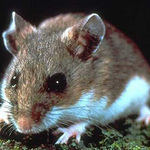
Posted by Stephanie Worley Firley, U.S. Forest Service, on March 26, 2015
Deer mice and chipmunks were among the dominant small mammals in the study area and were mostly unaffected by the fuel reduction treatments.
Forest managers in the western United States often face difficult choices when it comes to reducing wildfire hazards while also maintaining wildlife habitat in forests that have changed dramatically in the last century.
The U.S. Forest Service Pacific Southwest Research Station and partners are working to find the balance between forest restoration and habitat conservation in a new era of forest management.
To put the problem into context, you should consider how forests have changed in the last century. Over the past several decades, people have rushed to put out fires in what was thought to be a prudent attempt to save forest resources and the human communities that are increasingly blending with forests. This fire suppression and other activities, such as selective logging practices, have changed the dynamics in many forests, resulting in shifts of dominant tree species and thick vegetation that fuels wildfire.
Some sensitive wildlife species, such as California spotted owls, make their habitat in dense forest with old, large trees. However, many of those old-growth areas are now increasingly vulnerable to intense wildfire, especially as a backdrop to a changing climate that has served to extend the fire season.
Contemporary efforts to sustain forest habitat for wildlife species that use dense forest have limited managers’ options for restoring these same forests to a condition that is more resilient to disturbance, including wildfire. This apparent conundrum presents an enormous challenge and leaves forest managers grasping for solutions. How can managers maintain or restore suitable habitat conditions for those sensitive species and also prevent large, high-severity fires—the kind that can cause lasting damage to forest resources, including wildlife habitat?
Between 2003 and 2008 on Plumas National Forest in California, managers installed a coordinated landscape fuel network, or a patchwork of activities, including thinning and prescribed fire, designed to reduce forest fuels and severe wildfire risk. Following these treatments, researchers observed the effectiveness of the treatments and corresponding wildlife responses. Scientists recently published “California spotted owl, songbird and small mammal responses to landscape fuel treatments,” which also appeared in the journal BioScience.
Even with some areas in the network left untreated, researchers found that the treatments did reduce the overall risk of severe wildfire, but did not generally create a home environment conducive to a variety of wildlife, a characteristic of historic forest conditions in the Sierra Nevada.
“This project demonstrated that we can modify fire behavior and effects, but treatments across a larger landscape are necessary to reduce the chances for catastrophic events like the King and Rim Fires through time,” said Scott Stephens, the study’s lead author from the University of California, Berkeley.
Small mammals and songbirds in the forest appeared to be mostly unaffected by the fuel reduction treatments. Territories of California spotted owls declined following the treatments, although other factors may have played a role in this finding.
“Our research highlights the challenge of meeting multiple forest management objectives and emphasizes the need for careful monitoring of treatment effects and continued development of forest restoration strategies,” said John Keane, Forest Service research wildlife ecologist.
Researchers will continue to study the effects of these kinds of treatments across large landscapes, but believe that management activities to promote a mixture of forest patterns could provide the balanced solution that managers have long sought. Forests that provide a range of conditions, from open patches to groves of old, large trees, emulate a landscape historically forged by frequent, low-intensity fire. When these forests experience wildfire or other disturbances, they are likely to be more resilient and able to sustain conditions that meet the needs of sensitive wildlife.



